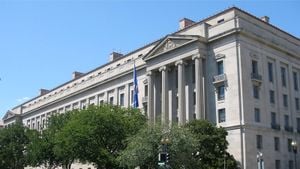For the first time, the giraffe might soon be classified as endangered under U.S. law, following alarming population declines of several subspecies. This significant proposal from the U.S. Fish and Wildlife Service (USFWS) aims to give these majestic animals—known for their long necks and distinctive spotted coats—federal protections, responding to the pressing challenges they face due to habitat loss, poaching, and climate change.
According to data from the USFWS, giraffe populations have seen dramatic decreases, with three subspecies—the West African, Kordofan, and Nubian giraffes—experiencing staggering declines of around 77% since 1985. Their numbers have plummeted from roughly 25,653 to just 5,919 individuals, indicating a troubling trend for this iconic species. Particularly concerning is the dire state of the West African giraffe, for which only about 690 remain.
Martha Williams, Director of the USFWS, emphasized the importance of the proposed federal protections. "Federal protections for giraffes will help protect a vulnerable species, promote biodiversity, support ecosystem health, combat wildlife trafficking, and encourage sustainable economic practices," she stated.
Under the Endangered Species Act, if this proposal is finalized, it would require permits for the import of giraffe body parts and products such as skins, tails, and even hunting trophies—an effective measure against illegal hunting and trading. Historically, the U.S. has been linked to nearly 40,000 imports of giraffe parts and products over the past decade, raising ethical and conservation concerns.
Besides the northern giraffe subspecies, the proposal also includes two subspecies of southern giraffes—the Angolan and South African—designated as threatened. Though less dire, this classification continues to reflect the concerning trend of giraffe populations as modern threats of urbanization and climate change loom large.
The turtles, elephants, and rhinos often draw most of the attention when discussing endangered species, yet giraffes have not wielded the same prominence—even as their plight draws comparisons to what some activists have termed the "silent extinction." Danielle Kessler, U.S. Director of the International Fund for Animal Welfare (IFAW), remarked on this phenomenon, encouraging swift action: "Losing giraffes would be devastating to Earth's biodiversity. We hope the USFWS will move quickly to finalize this decision and safeguard the future of these species."
According to experts, the mere existence of giraffes is interconnected with numerous ecosystems around them. Their shades and patterns contribute to their environment's biodiversity, playing roles as browsers and as prey to larger predators. By feeding on specific trees and plants, they also help manage and shape the overall structure of their habitats.
The proposed proposal for giraffe protections received positive feedback from conservation groups, which have been advocating for such measures. Many are hopeful, though cautiously optimistic, about the listing driving increased public awareness and funding for giraffe conservation efforts.
Despite these calls for action, the future protections may face political hurdles, especially with conversations about upcoming elections. Some fear political shifts could impact the administration's commitment to conservation efforts. Experts insist the urgency of the giraffe's predicament transcends political divisions, as the fate of this beloved animal lies not only within conservationists' hands but within the country's broader environmental policies.
While the USFWS action signifies progress, experts argue it may arrive much later than necessary. Stephanie Fennessy, Executive Director of the Giraffe Conservation Foundation, echoed this sentiment, emphasizing, "The attention for giraffes generated through this rule will help increase awareness of their plight and the fact not all giraffes are the same."
Giraffes, much like other animals facing extinction, rely on stable environments. The climate crisis compounds threats against them, with alterations to rainfall patterns leading to both droughts and flooding, affecting their food availability. Therefore, ensuring effective habitat protection is necessary for their survival.
The announcement also noted the agency’s intent to gather public comments on the proposed rule until February 19, 2025, with expectations to finalize the proposal within the following year. Interested parties can submit their feedback via the USFWS website. For conservationists and giraffe lovers alike, the impending decision will be pivotal, symbolizing both hope and urgency for the future of this remarkable species.
Looking beyond the stringent regulations proposed, many have expressed the need for funding support directed toward giraffe-specific research and conservation initiatives. Not only would such support bolster habitat restoration efforts, but it would also encourage local communities to engage positively with wildlife conservation efforts, promoting the concept of coexistence with these gentle giants.
Wildlife conservation needs collaborative engagement beyond government actions to drive sustainable practices. Against the backdrop of increasing threats to biodiversity, proactive measures—including education and community support—can play integral roles. Understanding the giraffe's plight means rethinking consumer habits related to wildlife products and advocating for nature's balance.
This proposed protection move sends ripples across various conservation efforts and speaks to the need for global awareness of the consequences wildlife faces amid urban expansion and climate emergencies. The giraffe—once seen gallivanting gracefully across the African savannas—now speaks volumes about the urgency of addressing humanity’s footprint on nature.
With giraffes poised on the brink of new protections, advocates remain keys to ensuring these majestic creatures have their place preserved within ecosystems, continuing to inspire generations long after we are gone. The giraffe’s struggle reflects broader environmental challenges, making their conservation not merely about the animals themselves but about all creatures shared on this planet.
Giraffes' impending listing can reshape conversations around endangered species, establishing new paths for wildlife conservation efforts. The coming months will reveal the U.S.'s commitment to giraffe protections and prompt public engagement as the clock ticks toward the final decision.
Everyone loves giraffes; they capture hearts with their enchanting presence and potential wisdom for future stewardship. Time will tell if politicians and decision-makers embrace their role to safeguard the future of this remarkable species, embracing the urgency of today’s conservation needs.



